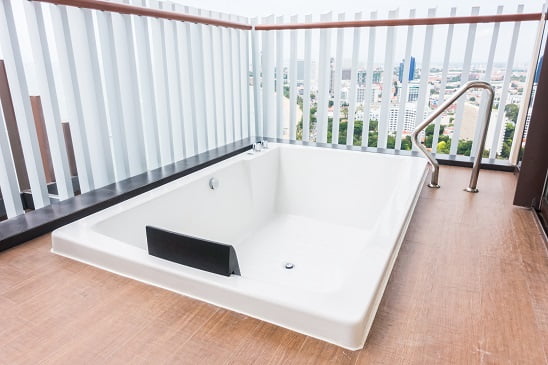Encountering a bathtub flooding scenario can be distressing, but having a clear plan of action can help alleviate the stress and minimize damage. This comprehensive 10-step guide aims to provide you with the essential knowledge and steps necessary to effectively handle bathtub flooding incidents. By following these steps, you can safeguard your property, ensure your safety, and efficiently restore your bathroom to its pre-flood condition.
1: Turn Off the Water
The first and most crucial step when faced with bathtub flooding is to immediately locate and turn off the water supply. This can usually be done by locating the shut-off valve near the bathtub or the main water supply valve for your home. By stopping the flow of water, you can prevent further flooding and mitigate potential water damage to your property. It’s important to act swiftly and decisively during this step to minimize the extent of the flooding and its impact on your home.
2: Address the Problem
Once you’ve stopped the flow of water, it’s essential to identify and address the root cause of the flooding. This may involve inspecting the bathtub drain for any obstructions, such as hair or debris, that may be causing the backup. If the issue lies within the plumbing system, such as a burst pipe or leaking faucet, you may need to enlist the help of a professional plumber to resolve the problem. Addressing the underlying issue promptly is crucial to prevent the recurrence of flooding and ensure the long-term integrity of your plumbing system.
3: Ensure Personal Safety
Before attempting to clean up the flooded area, it’s important to prioritize your safety and that of others in your household. Put on protective gear such as rubber gloves, boots, and safety goggles to minimize the risk of exposure to contaminated water and potential hazards. Be cautious when navigating wet surfaces to avoid slips, falls, or electrical shocks. If the flooding is severe or if there is any doubt about the safety of the environment, evacuate the area and seek assistance from emergency services. Taking the necessary precautions to ensure personal safety is paramount before proceeding with the cleanup process.
4: Notify Your Insurance Provider and Document the Damage
Dealing with bathtub flooding can be overwhelming, but it’s important to remain calm and proactive in handling the situation. Contact your insurance provider as soon as possible to report the incident and initiate the claims process. Be prepared to provide detailed information about the extent of the damage, including photographs, videos, and written descriptions.
Documenting the damage thoroughly will help support your insurance claim and ensure that you receive adequate compensation for the repairs. Keep track of any expenses incurred during the cleanup and restoration process, as these may also be covered by your insurance policy. By notifying your insurance provider and documenting the damage promptly, you can expedite the claims process and minimize any financial burden associated with the flooding incident.
5: Step Back and Assess
With the immediate safety concerns addressed and the water flow stopped, take a moment to step back and assess the situation. Evaluate the extent of the flooding and the damage it has caused to your property. Look for signs of water damage, such as warped flooring, stained walls, or sagging ceilings.
Check for any potential hazards, such as electrical outlets or appliances that may have been affected by the water. Assessing the situation thoroughly will help you formulate an effective plan for cleanup and restoration. If the flooding is severe or if you’re unsure about how to proceed, consider seeking assistance from a professional water damage restoration company. They can provide expert guidance and support to ensure that the cleanup process is carried out safely and effectively.
6: Prepare for Cleanup
Before you begin the cleanup process, gather all the necessary supplies and equipment you’ll need. This may include buckets, mops, sponges, towels, disinfectants, and protective gear. Clear the flooded area of any furniture or belongings to facilitate unobstructed access during cleanup. If the flooding has affected electrical outlets or appliances, turn off the power to the affected area to prevent the risk of electrical shock. It’s also a good idea to open windows and doors to promote air circulation and aid in the drying process. By preparing for cleanup properly, you can streamline the process and ensure that you have everything you need to restore your bathroom to its pre-flood condition.
7: Remove Standing Water
Once you’re prepared to begin the cleanup process, the next step is to remove any standing water from the flooded area. Depending on the severity of the flooding, you may need to use a variety of methods to extract the water. If the water level is relatively low, you can use buckets or a wet-dry vacuum to remove the water manually. For larger volumes of water, you may need to use a submersible pump or hire a professional water extraction service. Work systematically from one end of the room to the other, using towels or sponges to soak up any remaining water. Be sure to dispose of the water properly to prevent further damage or contamination. Removing standing water promptly is essential to prevent mold growth and minimize the risk of structural damage to your property.
8: Initiate Drying Process
With the standing water removed, it’s important to initiate the drying process as soon as possible. Excess moisture can lead to mold growth and further damage to your property if not addressed promptly. Open windows and doors to promote air circulation, and use fans, dehumidifiers, or heaters to expedite the drying process. Focus on areas that are prone to retaining moisture, such as carpets, upholstery, and drywall. If the flooding has affected walls or ceilings, you may need to remove damaged materials to allow for thorough drying. Monitor the humidity levels in the affected area and continue the drying process until moisture levels return to normal. By drying out the flooded area effectively, you can prevent mold growth and ensure the long-term integrity of your property.
9: Replace Damaged Drywall
Inspect the walls and ceilings of the flooded area for signs of water damage, such as discoloration, swelling, or soft spots. If any drywall has been compromised, it will need to be removed and replaced to prevent further structural damage and mold growth. Use a utility knife to cut away the damaged drywall, making sure to remove any wet insulation or other materials behind it. Once the affected area has been cleaned and dried, install new drywall and finish it as needed. Be sure to seal any gaps or cracks to prevent water infiltration in the future. If you’re unsure about how to replace damaged drywall, consider hiring a professional contractor to ensure that the job is done correctly. By replacing damaged drywall promptly, you can restore the structural integrity of your property and prevent future issues related to water damage.
10: Conclude with Disinfection
Once the cleanup and drying processes are complete, it’s essential to disinfect the affected area to eliminate any remaining bacteria, viruses, or contaminants. Use an EPA-approved disinfectant and follow the manufacturer’s instructions carefully to ensure effective sanitation. Pay special attention to high-touch surfaces such as countertops, fixtures, and bathroom accessories. If the flooding was caused by contaminated water, such as sewage backup, it’s especially important to thoroughly disinfect the area to prevent the spread of harmful pathogens.
FAQs: About Bathtub Flooding
What should I do immediately if my bathtub starts flooding?
Turn off the water supply to the bathtub by locating and shutting off the corresponding water valves. This is crucial to prevent further flooding.
How can I quickly remove excess water from the flooded bathtub?
Use a bucket, mop, or towel to soak up and remove as much water as possible. This helps minimize potential water damage and makes the cleanup process more manageable.
What should I check if my bathtub is still draining slowly after the flooding?
Inspect the bathtub drain for any visible clogs or debris. Use a plunger or a plumbing snake to clear obstructions and improve drainage.
Is it necessary to inspect the bathtub’s overflow drain in case of flooding?
Yes, inspect the overflow drain for potential clogs as they can contribute to bathtub flooding. Clean out any debris or hair that may be obstructing proper water flow.
How can I prevent future bathtub flooding incidents?
Regularly clean bathtub drains, use drain screens to catch debris and schedule professional plumbing maintenance. Additionally, be cautious with what goes down the drain to minimize the risk of clogs and flooding.
Conclusion:
In conclusion, effectively tackling a bathtub flooding incident requires a combination of swift action, thorough assessment, and diligent cleanup efforts. By following the comprehensive 10-step guide outlined above, you can navigate the challenges posed by water damage with confidence and efficiency. From promptly shutting off the water source to disinfecting the affected area, each step plays a crucial role in mitigating damage and restoring your bathroom to its pre-flood condition.
Furthermore, prioritizing personal safety throughout the cleanup process is paramount, as is documenting the damage for insurance purposes. Remember to seek professional assistance when needed, especially for addressing plumbing issues or extensive water damage.
Divine Wordsmith is a spiritual guide and writer, weaving tales of wisdom and insight to inspire inner growth and connection to the divine. Join the journey of self-discovery and enlightenment through the transformative power of words.




